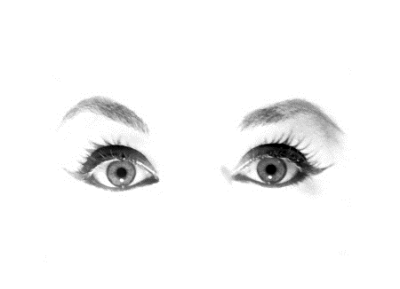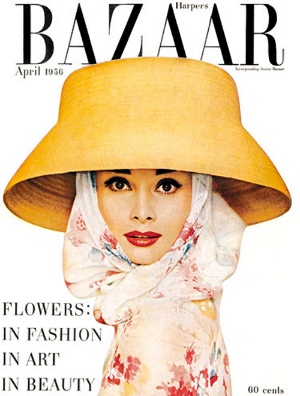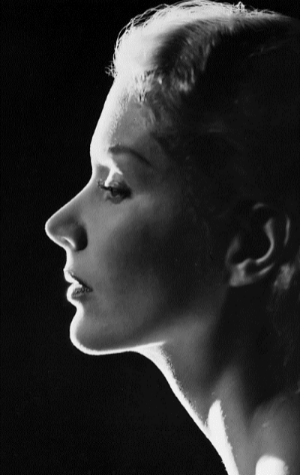The early fashion models that graced the covers of Vogue and Harper's Bazaar are still, in my humble opinion, some of the best models of all time. Swedish born, Lisa Bernstone was a descendant of the Gibson Girl, and was at one time the highest-paid, highest-praised high-fashion model in the business, considered, by many of her colleagues, even today still, to be the greatest fashion model of all time.
1935 photograph of Lisa Fonssagrives taken by her husband at the time, Fernand Fonssagrives
“I’m just a good clothes hanger.” If that is true, I'm not sure where that puts the rest of us! In 1949, Time magazine put Lisa Fonssagrives on its cover and dubbed her the billion-dollar baby with a billion-dollar smile and a billion-dollar salesbook in her billion-dollar hand,” The magazine goes further: “She is the new goddess of plenty.”

Fernand Fonssagrives photograph Lisa's Eyes
Lisa started out as a dancer and aspiring artist, but fate would lead her to the lenses of some of the world's most famous photographers, including; Erwin Blumenfeld, Anton Bruehl, Clifford Coffin, André Durst, Horst P. Horst, Frances McLaughlin-Gill, Herbert Matter. Norman Parkinson. Irving Penn, John Rawlings, Richard Rutledg, and George Hoyningen Huene. Her exquisite profile and willowy frame are instantly recognizable to anyone familiar with 20th century fashion.

Fernand Fonssagrives Diapositive - Lisa
Lisa met her first husband, Fernand Fonssagrives at a dance class in Paris. When Fernand hurt his back while dancing, Lisa handed him a camera and suggested that he take up photography. He sold the photos he took of his beautiful wife to various fashion magazines.
Lisa Fonssagrives in the late 1930s - photograph by George Hoyningen Huene
As Lisa explains in an interview with BOMB magazine, a chance encounter in an elevator launched what would become one of the most successful modeling careers of all time. "One day we were coming home after a very long day, and in the elevator (we lived on the 10th floor), a man told me that he was a photographer and asked if I would like to model hats for him. I was terribly shy but flattered that he would want me to pose. I was so young and naive."
"Anyway, I did these pictures with this man called Willy Maywald, and my husband took them up to Vogue. They asked me to do a test with Horst and I arrived terrified. I had never seen a fashion magazine, I didn’t know what fashion was. I made all my own clothes and I remember the suit I was wearing, dark brown wool, and I arrived so frightened with my hair long and wild and completely unmanageable."

How do you know what do do when you are the first supermodel in history? You can't watch America's Next Top Model, there really aren't any other models from whom you can learn your trade. After that famous photo test session with Horst, Lisa gave herself a crash course in modelling by spending hours at the Louvre, studying how people moved and observing how they acted in different types of clothing. I will let her words from the BOMB interview complete most of the remainder of this post, because no one can say it any more eloquently than Lisa herself.

Here is a gallery of several of Lisa's fashion magazine covers from Vogue and Harper's Bazaar










"But making a beautiful picture is making art, isn’t it? Especially with Huene, one really had the impression of creating something. He was very considerate, George Huene. He would set tile lights up before one arrived on the set, using a stand-in. So one was led from the dressing room onto a very dark, dramatic set with a column or stairway or some other greek-inspired element, and there was silence. It was like some mystic ritual. He spoke very little and in a very low voice and there was only one assistant, who moved like a cat."

"I would imagine what kind of woman would wear the gown I was wearing and assume different characters."
"I would look at myself in the dressing room mirror before going on the set and instinctively try to solve the photographer’s problems. I would look at the cut of the dress and try different poses to see how it fell best;, how the light would enhance it, and basically try to create a line the way one starts a drawing.

"I would stand before the camera on a set and concentrate my energy until I could sense it radiate into the lens and feel the photographer had the picture. It was very hard work! "
"I was terribly serious about being responsible and even studied photography to learn what the problems might be. I would objectify myself and become more of a director than an actress. I became this girl and not Lisa Fonssagrives. So that when I saw the contacts I would think, There that girl stands correctly, there she looks awkward…"
"There were no strobe lights in those days, but very hot spots, often live thousand watts on either side of you and the exposures were long. You could feel the sweat trickling down your face and the assistant would come over and hand you a towel."
"I remember one time in New York in the ‘50s when I was modeling fur coats in the summer. And there were no air conditioned studios then. It was so hot that I just fainted. And they propped me right back up and I went straight back to work. Can you imagine what would happen today if a model fainted on a set?"
"Often they constructed sets for the type of woman who would wear the clothes to be photographed. There was time to prepare and time to work, and the sense of collaboration and camaraderie was marvelous. It was also a kind of game, that exchange that takes place through the lens. That is why I hate the word “shooting.” It implies something so one-sided and impersonal. It was never a “shooting,” but a sitting or a seance."
On Erwin Blumenfeld: "He was marvelous. He made you feel so beautiful. He used to hold my face in his hands like some fragile flower, so gentle, to pose it in the right light." When asked if she was petrified during the Eiffel Tower shot: "No, I was too young and too strong. I was a dancer and a skier and very athletic. .."
The Moroccan Palace Irving Penn photograph sold for 396,000 at Christie's in 2007.
Lisa met the photographer Irving Penn at Penn’s memorable “12 Beauties” sitting for Vogue. Lisa would marry Penn in the summer of 1950, at the Chelsea register office just after he photographed her in the fall Paris collections in an old top-floor studio in Paris. She would be his muse and the love of his life.
In 1957, Lisa went on to design evening gowns for private clients and lines of clothing for Lord and Taylor
In the late 60s, Lisa stopped designing clothing and began taking drawing classes at the Art Students League. She started to spend so much time sculpting at the Penn's farm that the family moved there permanently.
In 1968, Lisa started exhibiting her sculpture and paintings in group shows.
In 1983, Lisa exhibited at a one-woman show at New York’s prestigious Marlborough Gallery, and had another solo show there in 1986.
According to Allene Talmey, a Vogue features editor, "Though often dressed to the nines, Fonssagrives was a barefoot soul who liked to swim in the nude. She was comfortable enough in her well-toned, slender body—her Barbie-doll waist could be cinched to a mere seventeen inches—to bare all before the camera, daringly sunbathing naked at the edge of a cliff; or pensive and fragile behind a harp’s long strings."
Irving and Lisa were together for 42 years, until her death.
On the occasion of their 40th wedding anniversary, Penn tells a reporter, “Each day is an enrichment.”
"Whenever I would come home after a vacation, rested, Vogue used to say to me: “We can’t use you for at least 10 days, you’re much too healthy looking.”
I think I would have really liked Lisa. I don't often say that about many fashion professionals, sadly, but she seemed to have her priorities straight and I respect and admire that. Even at 79 in the photo below, she still had that famously beautiful profile.
Just one year after this photo was taken, Lisa Fonssagrives-Penn died of pneumonia at the age of 80. I think I can safely say, there will never be anyone quite like her.
Or another profile quite as lovely.
“Billion-Dollar Baby.” Time, September 19, 1949. BOMB Magazine, Mia Fonssagrives, Voguepedia


Patti Johnson
What a wonderful article!
Thank you.
❤️
Nancy Reynolds
Just lovely. Only when looking at her pictures is when I wish to be young again! Thanks for sharing Lisa in a wonderfully written article and great pictures…